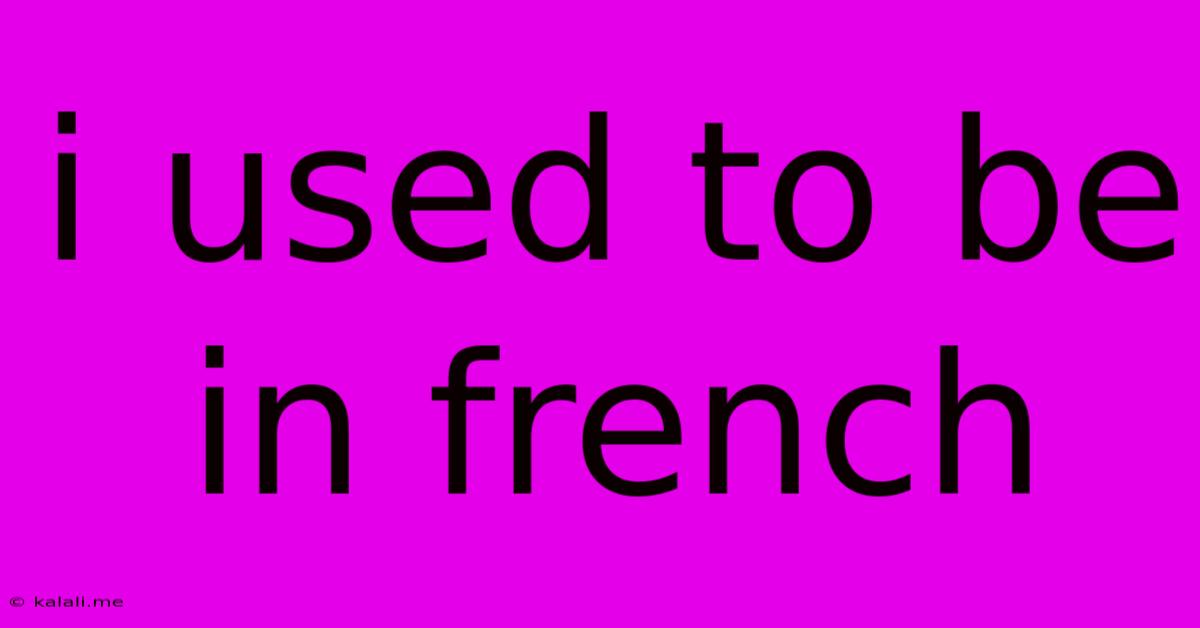I Used To Be In French
Kalali
May 22, 2025 · 3 min read

Table of Contents
I Used to Be in French: Navigating the Nuances of the Imparfait and Passé Composé
This article delves into the complexities of expressing past actions in French, specifically contrasting the imparfait and passé composé. Mastering these two tenses is crucial for accurately conveying the nuances of time and aspect in your French writing and speaking. Understanding when to use each will significantly improve the fluency and accuracy of your French.
Many learners struggle with the differences between the imparfait and passé composé. While both describe past events, they do so in distinct ways. This guide will break down their usage, providing clear examples and helping you confidently choose the right tense in any situation.
Understanding the Imparfait: Setting the Scene
The imparfait describes ongoing or habitual actions in the past. Think of it as setting the scene or providing background information. It paints a picture of the past, focusing on the state of being or repeated actions rather than completed events.
- Key characteristics:
- Ongoing actions: Je chantais. (I was singing.)
- Habitual actions: Je jouais au football tous les samedis. (I used to play football every Saturday.)
- Descriptions: Il était grand et maigre. (He was tall and thin.)
- States of being: Elle était heureuse. (She was happy.)
Mastering the Passé Composé: Actions Completed in the Past
The passé composé, on the other hand, focuses on completed actions in the past. These are actions that have a definite beginning and end. It's often used to narrate events in chronological order.
- Key characteristics:
- Completed actions: J'ai mangé un sandwich. (I ate a sandwich.)
- Single events: Elle est allée au cinéma. (She went to the cinema.)
- Actions with a specific result: J'ai fini mon travail. (I finished my work.)
The Crucial Distinction: When to Use Which Tense
The key to mastering the imparfait and passé composé lies in understanding their contrasting functions. Here's a breakdown:
-
Use the imparfait to:
- Describe the setting or background of a story.
- Describe habitual actions or routines.
- Describe states of being or conditions.
- Describe simultaneous actions.
-
Use the passé composé to:
- Narrate completed actions.
- Emphasize the result of an action.
- Describe a sequence of events.
- Highlight specific, punctuated actions within a longer narrative.
Example Scenario: Illustrating the Difference
Imagine describing a childhood memory:
Using only the passé composé (incorrect): J'ai vu un chien. J'ai couru. J'ai crié. (I saw a dog. I ran. I screamed.) This is a simple, factual recounting.
Using both tenses correctly: Il faisait beau. Je jouais dans le jardin quand j'ai vu un gros chien. J'ai couru et j'ai crié. (It was a beautiful day. I was playing in the garden when I saw a big dog. I ran and screamed.) This version paints a more vivid picture, setting the scene (il faisait beau, je jouais) before describing the completed actions (j'ai vu, j'ai couru, j'ai crié).
Beyond the Basics: Further Exploration
While this article provides a foundational understanding, further exploration of the plus-que-parfait (past perfect) and other past tenses will enhance your comprehension of French verb conjugation and narrative construction. Remember that practice is key. The more you immerse yourself in French language and literature, the more intuitive the use of these tenses will become. Don't be afraid to make mistakes; they are a vital part of the learning process.
Latest Posts
Latest Posts
-
Bag Of Holding Inside A Bag Of Holding
May 23, 2025
-
Butter My Butt And Call Me A Biscuit
May 23, 2025
-
How To Get A House In Riften
May 23, 2025
-
Side By Side Figures In Latex
May 23, 2025
-
How To Open A Stuck Drawer
May 23, 2025
Related Post
Thank you for visiting our website which covers about I Used To Be In French . We hope the information provided has been useful to you. Feel free to contact us if you have any questions or need further assistance. See you next time and don't miss to bookmark.